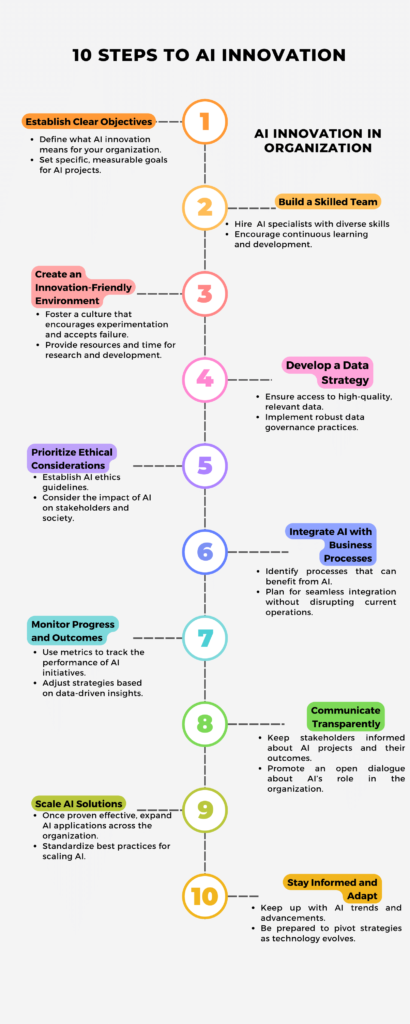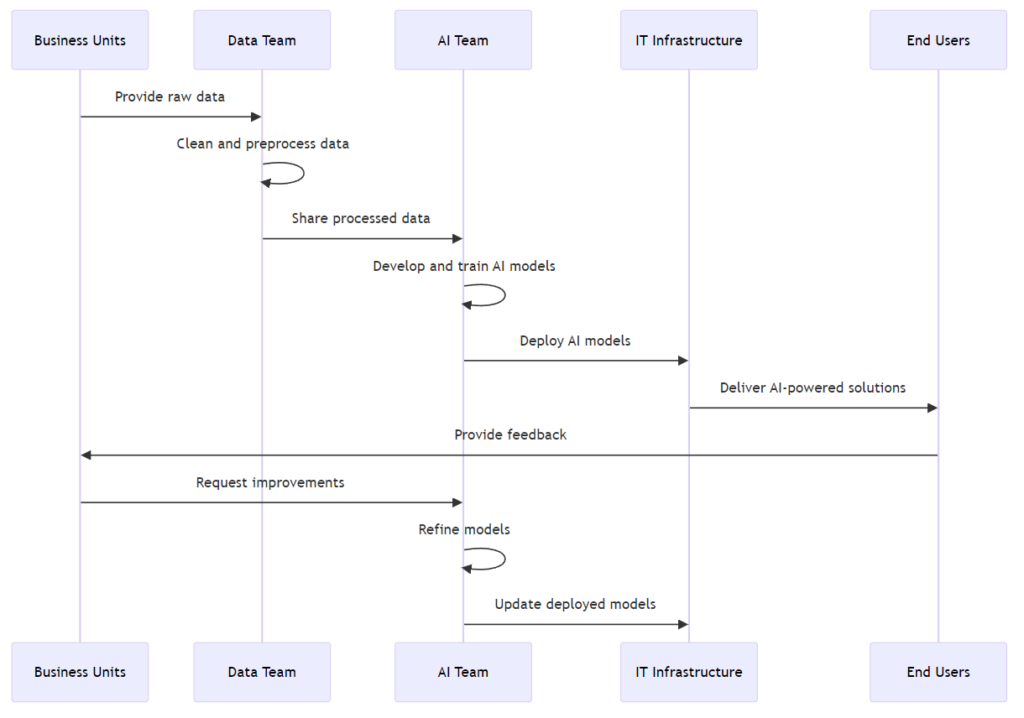In today’s rapidly evolving technological landscape, artificial intelligence (AI) has emerged as a transformative force with the potential to revolutionize industries and redefine the way we live and work. As businesses strive to remain competitive and adapt to ever-changing market dynamics, embracing AI innovation has become imperative. However, effectively managing AI within an organization presents a unique set of challenges and opportunities.
This comprehensive guide will delve into the intricacies of managing AI innovation, providing valuable insights and practical strategies to help your organization navigate this complex terrain.

1. Establishing a Clear AI Strategy
As a CTO or technology leader, your first step in managing AI innovation should be to establish a clear, organization-wide AI strategy. This strategy should align with your overall business objectives and address the following key areas:
- Identifying AI use cases: Collaborate with department heads to identify areas where AI can drive the most value. This might include process automation, predictive analytics, or enhancing customer experiences.
- Setting realistic goals: Define specific, measurable, achievable, relevant, and time-bound (SMART) goals for your AI initiatives.
- Resource allocation: Determine the budget, talent, and infrastructure needed to support your AI projects.
- Ethical considerations: Establish guidelines for responsible AI development and deployment, addressing issues such as bias, privacy, and transparency.
2. Building a Cross-Functional AI Team
Successful AI innovation requires a diverse team with a range of skills and perspectives. As an EA or Data Architect, you’ll play a crucial role in assembling and coordinating this team. Consider including:
- Data scientists and machine learning engineers
- Domain experts from relevant business units
- IT professionals for infrastructure and integration
- Legal and compliance experts
- UX designers for human-AI interaction
- Project managers to oversee implementation
Encourage collaboration and knowledge sharing among team members to foster a culture of innovation and continuous learning.
3. Developing a Robust Data Strategy
As the foundation of AI, data quality and accessibility are paramount. Work with your data team to:
- Assess your current data landscape: Identify available data sources, quality issues, and gaps.
- Implement data governance: Establish policies and procedures for data collection, storage, and usage.
- Invest in data infrastructure: Ensure you have the necessary tools and platforms to collect, process, and analyze large volumes of data.
- Promote data literacy: Educate employees across the organization about the importance of data and its role in AI initiatives.
4. Choosing the Right AI Technologies and Tools
With a plethora of AI technologies and tools available, selecting the right ones for your organization can be challenging. Consider the following factors:
- Scalability: Choose solutions that can grow with your organization’s needs.
- Integration capabilities: Ensure compatibility with your existing IT infrastructure.
- Ease of use: Look for tools that balance sophisticated capabilities with user-friendliness.
- Support and community: Opt for technologies with strong vendor support and active developer communities.
- Cost-effectiveness: Evaluate the total cost of ownership, including implementation, training, and maintenance.
5. Implementing AI Projects: A Phased Approach
To maximize success and minimize risks, adopt a phased approach to AI implementation:
- Proof of Concept (PoC): Start with small-scale pilots to validate the feasibility and potential impact of AI solutions.
- Minimum Viable Product (MVP): Develop a basic version of the AI solution with core functionalities.
- Iterative improvement: Continuously refine and expand the solution based on feedback and performance metrics.
- Full-scale deployment: Roll out the AI solution across the organization, ensuring proper change management and training.
6. Ensuring Ethical AI Development and Deployment
As AI becomes more prevalent in decision-making processes, ensuring ethical development and deployment is crucial. Consider the following steps:
- Develop an AI ethics framework: Establish guidelines for responsible AI development, addressing issues such as fairness, transparency, and accountability.
- Implement bias detection and mitigation techniques: Regularly audit AI models for potential biases and take corrective actions.
- Prioritize explainability: Invest in techniques and tools that make AI decision-making processes more interpretable and transparent.
- Stay informed about AI regulations: Keep abreast of evolving AI regulations and ensure compliance.
7. Fostering a Culture of AI Innovation
To truly harness the power of AI, it’s essential to foster a culture of innovation throughout your organization:
- Promote AI literacy: Offer training programs to help employees understand AI concepts and potential applications.
- Encourage experimentation: Create safe spaces for teams to explore and test new AI ideas.
- Celebrate successes and learn from failures: Recognize AI achievements and use setbacks as learning opportunities.
- Facilitate knowledge sharing: Organize regular forums for teams to share insights and best practices.
8. Measuring and Communicating AI Impact
To maintain support for AI initiatives and secure future investments, it’s crucial to measure and communicate the impact of your AI projects:
- Define key performance indicators (KPIs): Establish metrics that align with your business objectives and AI strategy.
- Implement monitoring and evaluation systems: Use analytics tools to track the performance of AI solutions in real-time.
- Conduct regular impact assessments: Evaluate the ROI of AI projects and their broader impact on the organization.
- Communicate successes and lessons learned: Share AI wins and insights with stakeholders across the organization.
9. Addressing AI Talent Challenges
The shortage of AI talent is a significant challenge for many organizations. To address this issue:
- Invest in upskilling and reskilling: Develop training programs to enhance the AI capabilities of your existing workforce.
- Partner with academic institutions: Collaborate with universities to access cutting-edge research and emerging talent.
- Consider AI-as-a-Service solutions: Leverage cloud-based AI services to supplement in-house capabilities.
- Create an attractive work environment: Offer challenging projects, continuous learning opportunities, and competitive compensation to attract and retain top AI talent.
10. Preparing for the Future of AI
As AI continues to evolve rapidly, it’s essential to stay ahead of the curve:
- Monitor emerging AI trends: Keep an eye on advancements in areas such as federated learning, edge AI, and quantum machine learning.
- Participate in AI communities and events: Engage with industry peers and thought leaders to stay informed about best practices and emerging technologies.
- Experiment with cutting-edge AI techniques: Allocate resources for exploring novel AI approaches that could provide a competitive advantage.
- Develop a long-term AI roadmap: Create a vision for how AI will transform your organization over the next 5-10 years and plan accordingly.
To better understand the data flow in AI implementation, consider the following sequence diagram:

Conclusion
Managing AI innovation within your organization presents both challenges and opportunities. By embracing the strategies outlined in this guide, you can effectively navigate this complex landscape, harnessing the power of AI to transform your business and gain a competitive edge. Remember, AI is a journey, not a destination. Embrace continuous learning, adaptation, and innovation to stay ahead of the curve and unlock the full potential of AI for your organization.
Ready to take your AI innovation to the next level? Our team of experienced consultants can help you develop and implement a tailored AI strategy that aligns with your business objectives. Contact us today for a personalized consultation and discover how we can support your AI journey.
References:
Davenport, T. H., & Ronanki, R. (2018). Artificial intelligence for the real world. Harvard Business Review, 96(1), 108-116.
Fountaine, T., McCarthy, B., & Saleh, T. (2019). Building the AI-powered organization. Harvard Business Review, 97(4), 62-73.
Ng, A. (2018). AI transformation playbook: How to lead your company into the AI era. Landing AI.
Disclaimer: This blog post is for informational purposes only and does not constitute professional advice. The implementation of AI technologies should be carefully considered in the context of your organization’s specific needs and circumstances. Always consult with qualified professionals before making significant changes to your IT infrastructure or business processes.
Trademark Notice: All product names, logos, and brands mentioned in this post are property of their respective owners. Use of these names, logos, and brands does not imply endorsement.
